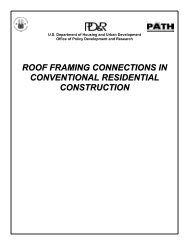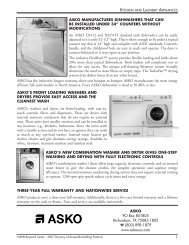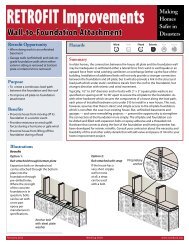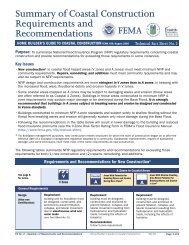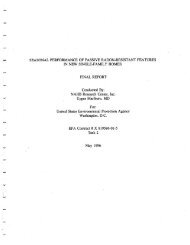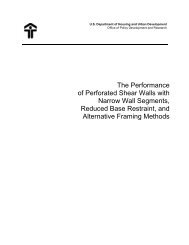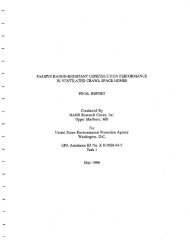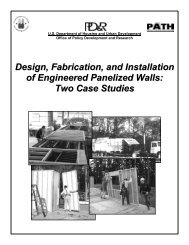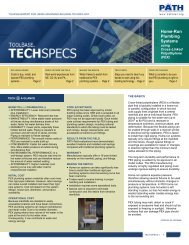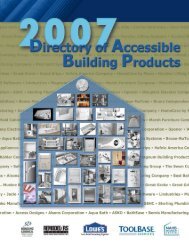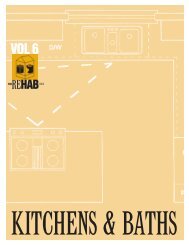The Rehab Guide, Volume 2: Exterior Walls - ToolBase Services
The Rehab Guide, Volume 2: Exterior Walls - ToolBase Services
The Rehab Guide, Volume 2: Exterior Walls - ToolBase Services
You also want an ePaper? Increase the reach of your titles
YUMPU automatically turns print PDFs into web optimized ePapers that Google loves.
5.2. GLASS MAT-FACED GYPSUM SHEATHING.A product recently developed by Georgia Pacific, Dens-Glass Gold combines inorganic glass matsembedded with a water resistant and silicone-treated gypsum core and an alkali-resistant surface treatment.<strong>The</strong> product is more water resistant and generally performs better than paper-faced gypsum sheathing,particularly as a substrate to EIFS and brick veneer. Available in 1 /2- and 5 /8-inch thicknesses andlengths of 8 to 10 feet, and greater on special order.ADVANTAGES: Resistant to wicking, moisture penetration, and delamination. Can be installed and exposed upto six months before application of finish siding. Superior performance compared to paper-faced gypsum.Can be used as a substrate for a wide variety of siding applications, but not as a nail-base. Does not requireadditional bracing for normal applications. As light-weight and easy to handle as paper-faced sheathing.DISADVANTAGES: Costs up to 50 percent more than paper-faced gypsum sheathing. R-value for 1 /2-inchthickness is 0.56; 5/8-inch thickness is 0.67, which is considerably less than for insulative sheathing.Cannot be used as a nail base for siding.5.3. GYPSUM SHEATHING MADE WITH A NON-PAPER-FACED BLEND OF CEL-LULOSE FIBER AND GYPSUM.Developed recently as a high-performing alternative to paper-faced boards by Louisiana Pacific,FiberBond fiber-reinforced wall sheathings are made from recycled newsprint, perlite, and gypsum,with a special water-resistant face treatment.ADVANTAGES: Stronger and more moisture resistant than paper-faced boards. Structural wall bracing;superior resistence to screw withdrawal. Can be used as a substrate for EIFS, brick veneer, and a varietyof other claddings. Higher impact strength than other gypsum sheathings; harder edges and ends.Available in up to 12-foot lengths. Uses recycled materials.DISADVANTAGES: Somewhat heavier than other 4 x 8 sheets of gypsum sheathing (paper-faced: 56 pounds,Dens-Glass: 64 pounds, FiberBond: 72 pounds). Priced comparable to Dens-Glass; significantly moreexpensive than paper-faced. Unfinished exposure limited to 60 days. Cannot be used as a nail base for sidings.6. REPLACE EXISTING SHEATHING WITH PAPERBOARD SHEATHING.In use for over 60 years, paperboard sheathing is a code- approved, low-cost alternative to the other structuralsheathings, and has found a considerable following among large home builders for new construction.Available from Simplex Products Division (<strong>The</strong>rmo-Ply) and other manufacturers, in thicknessesfrom 0.078 to 0.137 inch, it can be obtained in sheets up to 80 inches wide and 16 feet long, with bothreflective foil surfaces and non-reflective. Vapor-permeable sheathing is under development. It is oftenavailable to builders with their own private label.ADVANTAGES: Does not require additional shear bracing. Recognized as structural sheathing by nationalmodel codes. Less expensive than other sheathing alternatives. Excellent air infiltration resistance due tooverlapping joints.DISADVANTAGES: Thinness of the material makes it difficult to use in small-scale rehab projects as infillfor thicker sheathing products. Not as strong as OSB or plywood. Sheathing material has R-value of 0.2, butis claimed to be greater with reflective surface and air space, but less than other insulating sheathing. Mayrequire adjustments to wood window trim detailing due to thinness of material. Cannot be used as a nailbasefor siding products.307. REPLACE EXISTING SHEATHING WITH FIBER-CEMENT SHEATHING.A number of fiber-cement sheathing products are available as structural sheathing underlayments. <strong>The</strong>seproducts range from 30-year-old cement and wood fiber products such as Wonderboard, to high-techfiber-cement products such as Hardiboard and Eternit, which perform well in high-moisture locations.As such, they are frequently used as underlayments for thin brick, tile, and EIFS.ADVANTAGES: Good performance in high-moisture locations. Resistant to face delamination.Noncombustible, strong, and rigid.DISADVANTAGES: More costly than gypsum board and other types of sheathing. Not typically used forsiding systems other than for EIFS.



